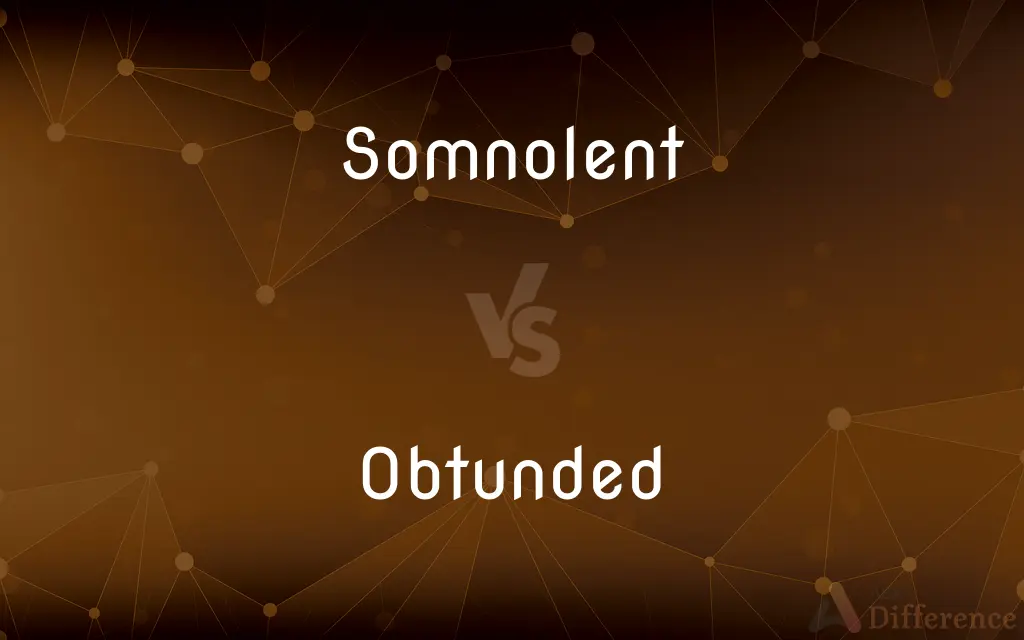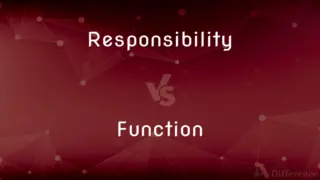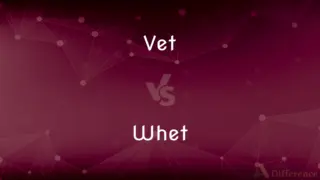Somnolent vs. Obtunded — What's the Difference?
By Tayyaba Rehman & Maham Liaqat — Updated on March 29, 2024
Somnolent describes a state of drowsiness or sleepiness, whereas obtunded refers to a dulled or blunted alertness.

Difference Between Somnolent and Obtunded
Table of Contents
ADVERTISEMENT
Key Differences
Somnolence is characterized by a strong desire for sleep or frequent lapses into sleep, often seen as a symptom in various medical conditions or as a side effect of medications. In contrast, obtundation signifies a state of reduced alertness and a decreased interest in the environment, which can also result from medical conditions or drug effects but indicates a more severe level of impaired consciousness than somnolence.
Patients described as somnolent can usually be aroused with mild stimuli, such as a loud noise or light touch, and are capable of interaction, although they may be sluggish or inclined to fall back asleep. On the other hand, obtunded individuals respond to stimuli more slowly and with less full awareness; their responses may be limited, and they may require more significant stimuli to elicit a reaction.
The assessment of a somnolent individual focuses on identifying the cause of their drowsiness to address it effectively, such as adjusting medication, treating underlying sleep disorders, or managing pain. For someone who is obtunded, the medical priority includes ensuring the airway is protected, monitoring vital signs closely, and often requires more immediate interventions to prevent further decline in their level of consciousness.
Somnolence can occur in otherwise healthy individuals who are simply sleep-deprived or in the context of benign conditions such as jet lag. Obtundation, however, is more frequently associated with serious medical conditions such as brain injuries, significant infections, or metabolic imbalances, necessitating a thorough medical evaluation to determine its cause.
The management of somnolence might involve lifestyle adjustments, sleep hygiene improvements, or changes in medication. Managing obtundation often requires hospitalization to monitor and treat the underlying cause aggressively, which might include administering medications to manage infections, correct metabolic disorders, or reduce brain swelling.
ADVERTISEMENT
Comparison Chart
Definition
A state of drowsiness or desire for sleep.
Reduced alertness and interest in surroundings.
Responsiveness
Can be aroused with mild stimuli.
Requires more significant stimuli to respond.
Associated Conditions
Sleep deprivation, medication side effects.
Brain injuries, infections, metabolic imbalances.
Severity
Less severe level of consciousness impairment.
Indicates more severe impairment.
Management
Lifestyle adjustments, sleep hygiene.
Often requires hospitalization and aggressive treatment.
Compare with Definitions
Somnolent
Prone to sleepiness or drowsiness.
The somnolent patient nodded off during the examination.
Obtunded
Exhibits blunted alertness.
The obtunded patient responded sluggishly to verbal commands.
Somnolent
Often a side effect of medications.
The new prescription made her noticeably somnolent.
Obtunded
May indicate serious medical issues.
His obtunded state was due to a severe brain injury.
Somnolent
Can be managed with lifestyle changes.
Improving sleep hygiene helped reduce his somnolence.
Obtunded
Less interaction with the environment.
She was so obtunded that she barely noticed her surroundings.
Somnolent
Easily aroused but seeks to return to sleep.
Despite being somnolent, he answered the doctor's questions.
Obtunded
Response to stimuli is significantly delayed.
Obtunded individuals might not respond immediately to light or sound.
Somnolent
Associated with sleep deprivation.
Working night shifts left her perpetually somnolent.
Obtunded
Requires immediate medical intervention.
The obtunded child was rushed to intensive care.
Somnolent
Drowsy; sleepy.
Obtunded
To make less intense; dull or deaden.
Somnolent
Inducing or tending to induce sleep; soporific.
Obtunded
Simple past tense and past participle of obtund
Somnolent
Drowsy or sleepy.
Obtunded
(medicine) Far from alert or oriented to time and space, and exhibiting other signs of being confused, a state just short of frank delirium.
Somnolent
(dated) Causing literal or figurative sleepiness.
Somnolent
Sleepy; drowsy; inclined to sleep.
He had no eye for such phenomena, because he had a somnolent want of interest in them.
Somnolent
Inclined to or marked by drowsiness;
Slumberous (or slumbrous) eyes
`slumbery' is archaic
The sound had a a somnolent effect
Common Curiosities
What are common causes of somnolence?
Common causes include lack of sleep, certain medications, and conditions that disrupt sleep, like sleep apnea or restless leg syndrome.
How does obtunded differ from comatose?
Obtundation implies a dulled or blunted alertness with reduced responsiveness, while a comatose state is a deep unconsciousness from which a person cannot be aroused.
Can somnolence be treated at home?
Somnolence caused by factors like sleep deprivation or medication side effects can often be managed with lifestyle adjustments and sleep hygiene improvements at home.
What does it mean when someone is described as somnolent?
Being somnolent means the person is in a state of sleepiness or drowsiness, often able to be awakened but inclined to fall back asleep.
What role does medication play in managing obtundation?
Medications may be used to address specific causes of obtundation, such as antibiotics for infections or medications to reduce brain swelling.
Why is obtundation a medical emergency?
Obtundation can signify serious underlying conditions requiring immediate intervention to prevent further decline in consciousness and ensure vital functions are maintained.
Is it possible for somnolence to lead to obtundation?
While somnolence itself is less severe, neglecting the underlying cause of persistent or worsening somnolence could potentially lead to more severe states like obtundation.
How is obtundation assessed in a medical setting?
Medical assessment of obtundation involves checking the person’s responsiveness to verbal and physical stimuli, evaluating vital signs, and often conducting imaging studies to identify underlying causes.
How do healthcare providers manage obtundation?
Management involves hospitalization, monitoring vital signs, protecting the airway, and treating the underlying cause aggressively.
Can both somnolence and obtundation occur in the same individual?
Yes, an individual's condition can progress from somnolence to obtundation if the underlying cause worsens or is not adequately addressed.
What is the prognosis for someone who is obtunded?
The prognosis depends on the underlying cause; with timely and appropriate treatment, some patients can recover fully, while others may have lingering effects.
What might cause a person to become obtunded?
Causes can include severe brain injuries, infections affecting the brain, metabolic imbalances, or intoxication with drugs or alcohol.
Can lifestyle changes affect somnolence?
Yes, improving sleep hygiene, adjusting diet, and managing stress can significantly reduce somnolence in many cases.
Are there preventive measures for somnolence?
Preventive measures include maintaining a regular sleep schedule, avoiding sleep disruptors like caffeine and screens before bedtime, and managing health conditions that affect sleep.
How do families cope with a somnolent or obtunded family member?
Families may need to adjust their routines, seek medical advice for management strategies, and in cases of obtundation, prepare for possible long-term care needs.
Share Your Discovery

Previous Comparison
Responsibility vs. Function
Next Comparison
Vet vs. WhetAuthor Spotlight
Written by
Tayyaba RehmanTayyaba Rehman is a distinguished writer, currently serving as a primary contributor to askdifference.com. As a researcher in semantics and etymology, Tayyaba's passion for the complexity of languages and their distinctions has found a perfect home on the platform. Tayyaba delves into the intricacies of language, distinguishing between commonly confused words and phrases, thereby providing clarity for readers worldwide.
Co-written by
Maham Liaqat













































